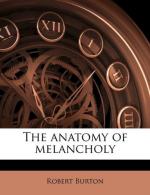They are (as others suppose) appointed by those higher powers to keep men from their nativity, and to protect or punish them as they see cause: and are called boni et mali Genii by the Romans. Heroes, lares, if good, lemures or larvae if bad, by the stoics, governors of countries, men, cities, saith [1124]Apuleius, Deos appellant qui ex hominum numero juste ac prudenter vitae curriculo gubernato, pro numine, postea ab hominibus praediti fanis et ceremoniis vulgo admittuntur, ut in Aegypto Osyris, &c. Praestites, Capella calls them, “which protected particular men as well as princes,” Socrates had his Daemonium Saturninum et ignium, which of all spirits is best, ad sublimes cogitationes animum erigentem, as the Platonists supposed; Plotinus his, and we Christians our assisting angel, as Andreas Victorellus, a copious writer of this subject, Lodovicus de La-Cerda, the Jesuit, in his voluminous tract de Angelo Custode, Zanchius, and some divines think. But this absurd tenet of Tyreus, Proclus confutes at large in his book de Anima et daemone.
Psellus [1125], a Christian, and sometimes tutor (saith Cuspinian) to Michael Parapinatius, Emperor of Greece, a great observer of the nature of devils, holds they are corporeal [1126], and have “aerial bodies, that they are mortal, live and die,” (which Martianus Capella likewise maintains, but our Christian philosophers explode) “that they [1127]are nourished and have excrements, they feel pain if they be hurt” (which Cardan confirms, and Scaliger justly laughs him to scorn for; Si pascantur aere, cur non pugnant ob puriorem aera? &c.) “or stroken:” and if their bodies be cut, with admirable celerity they come together again. Austin, in Gen. lib. iii. lib. arbit., approves as much, mutata casu corpora in deteriorem qualitatem aeris spissioris, so doth Hierome. Comment. in epist. ad Ephes. cap. 3, Origen, Tertullian, Lactantius, and many ancient Fathers of the Church: that in their fall their bodies were changed into a more aerial and gross substance. Bodine, lib. 4, Theatri Naturae and David Crusius, Hermeticae Philosophiae, lib. 1. cap. 4, by several arguments proves angels and spirits to be corporeal: quicquid continetur in loco corporeum est; At spiritus continetur in loco, ergo. [1128]Si spiritus sunt quanti, erunt corporei: At sunt quanti, ergo. sunt finiti, ergo. quanti, &c. Bodine [1129]goes farther yet, and will have these, Animae separatae genii, spirits, angels, devils, and so likewise souls of men departed, if corporeal (which he most eagerly contends) to be of some shape, and that absolutely round, like Sun and Moon, because that is the most perfect form, quae nihil habet asperitatis, nihil angulis incisum, nihil anfractibus involutem, nihil eminens, sed inter corpora perfecta est perfectissimum; [1130]therefore all spirits are corporeal he concludes, and in their proper shapes




